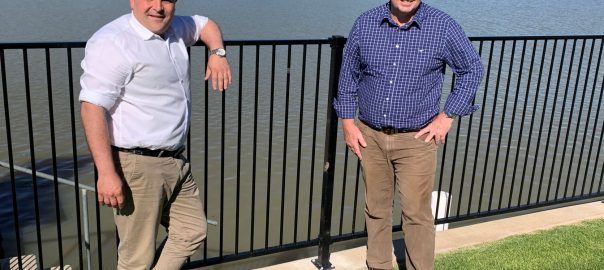FLOODPLAIN INFRASTRUCTURE PROGRAM CELEBRATES 10 SUCCESSFUL YEARS

A decade of new water infrastructure in South Australia’s Riverland funded by an innovative $155 million Australian Government program has delivered major, tangible improvements to the river ecosystem and boosted the local economy.
Minister for Resources and Water Keith Pitt said the comprehensive environmental project – the South Australian Riverland Floodplains Integrated Infrastructure Program (SARFIIP) – celebrated 10 successful years this month.
“This major program saw the construction of infrastructure including regulators, fishways and blocking banks so water could reach iconic floodplain sites in this critically important part of the river system,” Minister Pitt said.
“Three regulators and fishways were constructed on the Pike Floodplain, as well as a 6km levy to enable the managed watering of up to 2,200 hectares of floodplain.”
He said 25 bores were installed to limit the amount of saline groundwater getting under onto the Pike Floodplain and a further 5 floodplain bores were installed to increase the extent of fresh groundwater under the floodplain.
“At Katarapko, one new regulator with fishway was constructed at the top end of the floodplain to enable 15 times the volume of water travel down Eckerts Creek,” Minister Pitt said.
“Seven regulators were constructed adjacent to Katarapko Creek to water 1,100 hectares of the Katarapko Floodplain.
“The removal of major barriers to improve flow and fish passage as well as bank upgrades, required major coordination, engineering know-how and detailed planning.
“This extensive infrastructure project has been a joint government initiative, critically supported by community knowledge and input and will provide a valuable legacy for future generations.”
Federal Member for Barker, Tony Pasin MP said the with the new infrastructure in place, both Pike and Katarapko floodplains benefited from environmental water in 2020 and 2021, providing a range of ecological benefits and valuable habitat for a variety of species.
“This infrastructure has enabled significant improvements in the overall health and resilience of the landscape to be achieved over the coming years,” Mr Pasin said.
“Species such as frogs, turtles, and birdlife have thrived since regular environmental watering has taken place at the floodplains.
“From August to late November 2021, the floodplain regulators at Chowilla, Pike and Katarapko were operated concurrently for the first time, along with weir pool raising at Locks 6, 5, 4 and 2. This delivered water across over 1,100 hectares of floodplain throughout spring.
Mr Pasin said the Salinity Management Scheme situated along the Sturt Highway at Paringa, had prevented large amounts of salt each day from entering the Pike Floodplain.
“Since the start of the project, 20,000 tonnes of salt and 480 megalitres – or almost half a billion litres – of saline water have been pumped to Noora.
“This has helped maximise water available as well as minimise the risks to the environment and the community.”
He said this significant investment has boosted the local economy over the past 10 years.
“This Australian Government-funded infrastructure program has employed over 70 fulltime staff, including many locals, and furthermore, millions have been spent contracting local companies to supply food and accommodation and other services.”
Funded through a generous $155 million investment from the Australian Government, SARFIIP was coordinated by the Murray–Darling Basin Authority and delivered by the SA Department for Environment and Water in partnership with SA Water.
To wrap up SARFIIP and celebrate its success, a short film has been created to share the great results of the program. To view the video visit: SARFIIP | Main : Version 3 (vimeo.com)
ENDS








